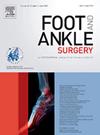接受全踝关节置换术患者的中位年龄在 1999 年至 2023 年间没有明显变化:前瞻性研究的系统回顾。
IF 1.9
3区 医学
Q2 ORTHOPEDICS
引用次数: 0
摘要
简介全踝关节置换术(TAR)是治疗终末期骨关节炎的有效方法。本系统综述旨在评估前瞻性比较研究中接受全踝关节置换术的患者年龄。我们的假设是,最新论文中报告的年龄可能低于较早论文中报告的年龄:本系统综述使用 Pubmed、Scopus、EMBASE 和 Cochrane 数据库。只纳入了有关 TAR 的一级和二级研究。提取的数据涉及人口统计学、研究设计、每项研究中的队列数量、发表年份以及实施手术的年份。为了比较不同时期手术患者的年龄,我们根据发表年份对患者进行了两方面的分析,并创建了 1) 两组(中位数年份之前和之后)和 2) 三组(使用三等分法)。此外,还考虑了接受TAR手术患者的中位年份,进行了比较:共纳入59个队列(42项研究,发表于1999年至2023年;发表年份中位数为2017年)(6397个脚踝,6317名患者,年龄中位数为63岁)。2016年之前发表的27个队列的中位年龄(加权中位数63岁;IQR,62.5-64)与2017年之后发表的32个队列的中位年龄(加权中位数63.2岁;IQR,63-67.8)之间的差异无统计学意义(P = 0.09)。按三等分法划分,手术时的加权中位年龄(T1(1999-2014 年;63.2 岁;IQR, 62.8-64.1)、T2(2015-2018 年;63 岁;IQR,63-63.5)和 T3(2019-2023 年;63.2 岁;IQR, 62.6-67.8))随时间的推移无明显变化(p = 0.65)。1999年至2008年与2009年至2023年期间手术患者的中位年龄(来自48个队列的数据)也没有差异(P = 0.12):结论:根据对1999年至2023年期间发表的前瞻性研究的回顾,在过去20年中,接受TAR手术的患者的中位年龄为63岁,随着时间的推移保持稳定,没有显著变化:II级--系统回顾,包括I级和II级研究。本文章由计算机程序翻译,如有差异,请以英文原文为准。
Median age of patients undergoing total ankle replacement has not significantly changed between 1999 and 2023: A systematic review of prospective studies
Introduction
Total ankle replacement (TAR) is an effective treatment for end-stage osteoarthritis. The aim of this systematic review was to assess the age of patients undergoing TAR in prospective comparative studies. Our hypothesis is that the age reported in most recent papers might be lower than those reported in older papers.
Methods
This systematic review was performed using Pubmed, Scopus, EMBASE and Cochrane databases. Only Level I and II studies dealing with TAR were included. Data regarding demographics, study design, number of cohorts in each study, year of publication and year/years in which surgery was performed were extracted. A two-fold analysis was conducted building groups of patients based on the year of publication and creating 1) two groups (before and after the median year) and 2) three groups (using tertiles) in order to compare age of patients operated in different period of times. A comparison was also performed considering the median year of surgery for patients undergoing TAR.
Results
Overall 59 cohorts (42 studies, published between 1999 and 2023; median year of publication: 2017) were included (6397 ankles, 6317 patients, median age 63 years). The difference between the median age for 27 cohorts published until 2016 (weighted median 63 years; IQR, 62.5–64) and the median age for 32 cohorts published after 2017 (weighted median 63.2 years; IQR, 63–67.8) was not statistically significant (p = 0.09). The division in tertiles did not reveal any significant change in the weighted median age at surgery (T1 (1999–2014; 63.2 years; IQR, 62.8–64.1), T2 (2015–2018; 63 years; IQR,63–63.5) and T3 (2019–2023; 63.2 years; IQR, 62.6–67.8)) over time (p = 0.65). The median age of patients operated between 1999 and 2008 vs 2009 and 2023 (data from 48 cohorts) was not different either (p = 0.12).
Conclusion
According to this review of prospective studies published between 1999 and 2023, the median age for patients undergoing TAR over the last two decades has been 63 years, remaining steady with no significant changes over time.
Level of evidence
Level II - systematic review including Level I and Level II studies
求助全文
通过发布文献求助,成功后即可免费获取论文全文。
去求助
来源期刊

Foot and Ankle Surgery
ORTHOPEDICS-
CiteScore
4.60
自引率
16.00%
发文量
202
期刊介绍:
Foot and Ankle Surgery is essential reading for everyone interested in the foot and ankle and its disorders. The approach is broad and includes all aspects of the subject from basic science to clinical management. Problems of both children and adults are included, as is trauma and chronic disease. Foot and Ankle Surgery is the official journal of European Foot and Ankle Society.
The aims of this journal are to promote the art and science of ankle and foot surgery, to publish peer-reviewed research articles, to provide regular reviews by acknowledged experts on common problems, and to provide a forum for discussion with letters to the Editors. Reviews of books are also published. Papers are invited for possible publication in Foot and Ankle Surgery on the understanding that the material has not been published elsewhere or accepted for publication in another journal and does not infringe prior copyright.
 求助内容:
求助内容: 应助结果提醒方式:
应助结果提醒方式:


